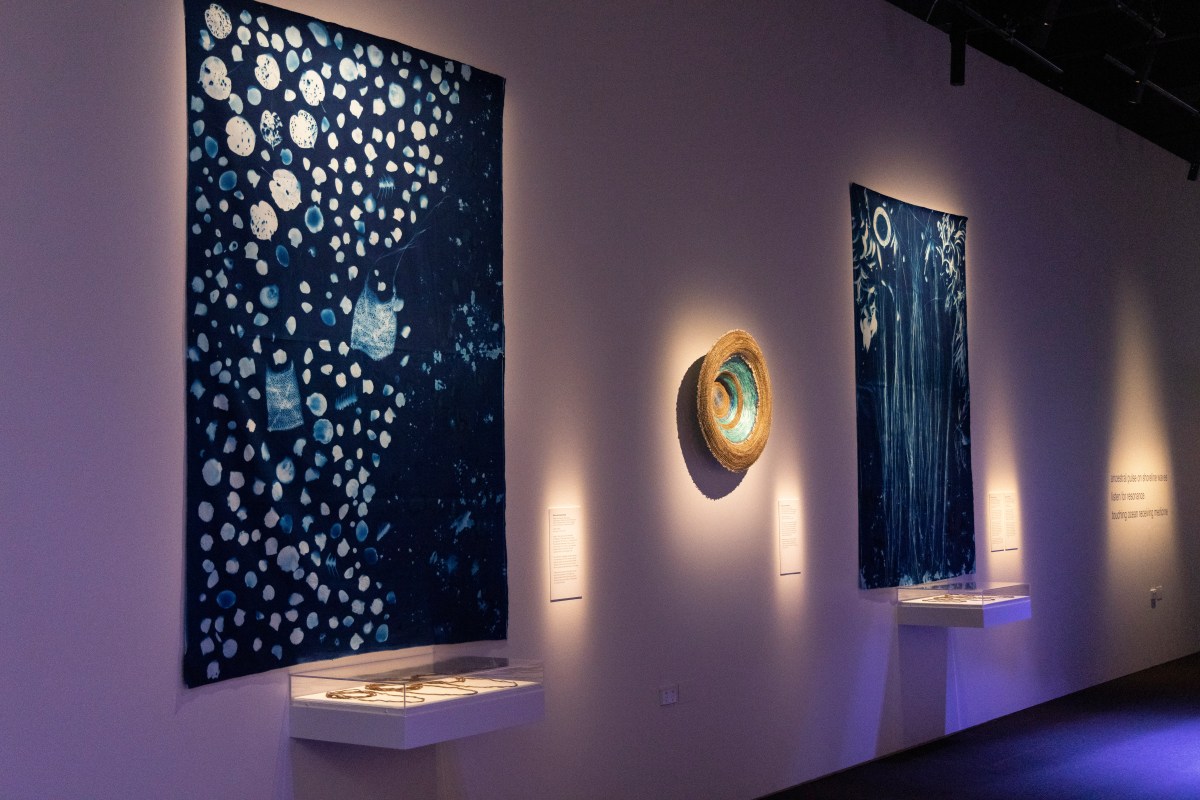Naadohbii: To Draw Water is an exhibition of over 20 First Peoples Artists at the Bunjilaka Aboriginal Cultural Centre, Melbourne Museum, initiated by Winnipeg Art Gallery (WAG-Qaumajug) in partnership with Museums Victoria and New Zealand’s Pātaka Art + Museum.
In Naadohbi artists draw upon their personal and ancestral practices, stories, and knowledge systems respecting fresh and salt water not only as a resource for life, but as Country’s sustenance, and as life itself.
The artists’ approaches to water’s sacredness and protection vary, but among them is a theme of revival. Entering the first gallery, the Birrarung, I was instantly drawn to Uncle Rex Greeno’s nighgr, a paperbark canoe he built as part of his revival of ancestral Tasmanian Aboriginal peoples’ practice. Raised to the imagined level of a river, it floats close to the curving gallery wall, which here registers as a shoreline.
Next to nighgr is Regina Pilawuk Wilson’s Walipan 1, 2, 3, and 4 (Fish Net). Woven from naturally dyed pandanis, they hang from the ceiling full and inflated, as if suspended in the Peppimenarti community streams and pools, awaiting their catch. Inspired by her weaving practice, Wilson’s large acrylic paintings with their intricate, abstracted fibre sequences appear to transform their two-dimensional canvases into pulsing, enlivened entities and explore an ancestral practice through a contemporary lens.
In contrast to these works of revival, James Tylor’s black and white photographs, Economies of Water, record and broadcast the irreparable devastation of the Murray Darling Basin. Dead, broken trunks and dry, barren lands extend into the distance, but the viewer’s capacity to access these landscapes is obstructed by gold, geometric pieces of vinyl laminate. In one of the five photographs, only the branches of a dead tree trunk are visible. We know that life is present somewhere, there’s a bird’s nest on the high branch, but the trunk is blocked by an impenetrable rectangle.
Marianne Nicholson’s A Feast of Light and Shadows comprises 30 enamel bowls laid out in two rows before a window, catching the shadows of the changing light. I visited in the early afternoon, and it looked like a crescent of water had collected at the top of each bowl. This work registers as a gentle protest and visual description of the need to share rather than accumulate wealth and remain responsive to scarcity. Examples of more explicit protest art are seen with the Onaman Collective’s black, white, ochre red, and mustard banners, declaring ‘water is sacred’ and protesting pipelines on behalf of animal clans, including beaver, caribou, and lynx.
At the mouth of the second gallery, I felt like I was standing before an underwater cave, with sounds from the works within overlaying to produce the sense of water groaning, singing.
Vicki Couzen’s kooramookyan (possum skin cloak) kooyang yandaa and etchings hold stories about the enduring relationships between animal kin and waterways, and how these are mapped by the constellations. Another artist who incorporates storytelling from the sky and traces stars to decolonise our sense of time is Nikau Hindin, with her aute and pigment work Te Awa Tupuna.
Lindsay Dawn Dobbin’s Touching ocean, receiving medicine invites you to place your hands on a large drum and feel the vibrations of the ocean, in doing so eliciting an act of listening. Physically listening to the ocean, the sense you get that it feels you in return is profound. Here is a drum not for beating.
Read: Exhibitions reviews: Rhythms of the Earth and Where Lakes Once Had Water
Continuing with the idea of the gallery as an underwater cave, the back of the gallery, where sounds and visuals of four video works combine, is the deepest point of immersion. No durations are given and each of the works play on a loop – an apt anti-colonial act allowing the time of the works to remain cyclic – not insisting or prescribing how viewers see and experience the work. As the oral historian Dinah Paul says in speaking of the Waipao waterways, in one of the videos comprising Nova Paul’s work ko te ripo, none of us ‘will see the same thing, at the same time, from the same angle’.
Featured Artists:
- Australian Artists: Vicki Couzens, Ishmael Marika, James Tylor, Elisa Jane Carmichael, Nici Cumpston, Regina Pilawuk Wilson.
- From Museums Victoria Collection for Melbourne Iteration: Rex Greeno.
- Turtle Island (North America) Artists: Christi Belcourt, Rebecca Belmore, Lindsay Dawn Dobbin, Maria Hupfield, Marianne Nicolson, Onaman Collective (Christi Belcourt and Isaac Murdoch).
- From the Winnipeg Art Gallery Collection: William Noah, Jessie Oonark.
- Aotearoa (New Zealand) Artists: Israel Birch, Nikau Hindin, Jeremy Leatinu’u, Nova Paul, Rachael Rakena, Keri Whaitiri.
Tickets to the exhibition will be included with Melbourne Museum general entry.
Naadohbii: To Draw Water will be at Bunjilaka Aboriginal Cultural Centre, Melbourne Museum until Sunday 26 March 2023.





